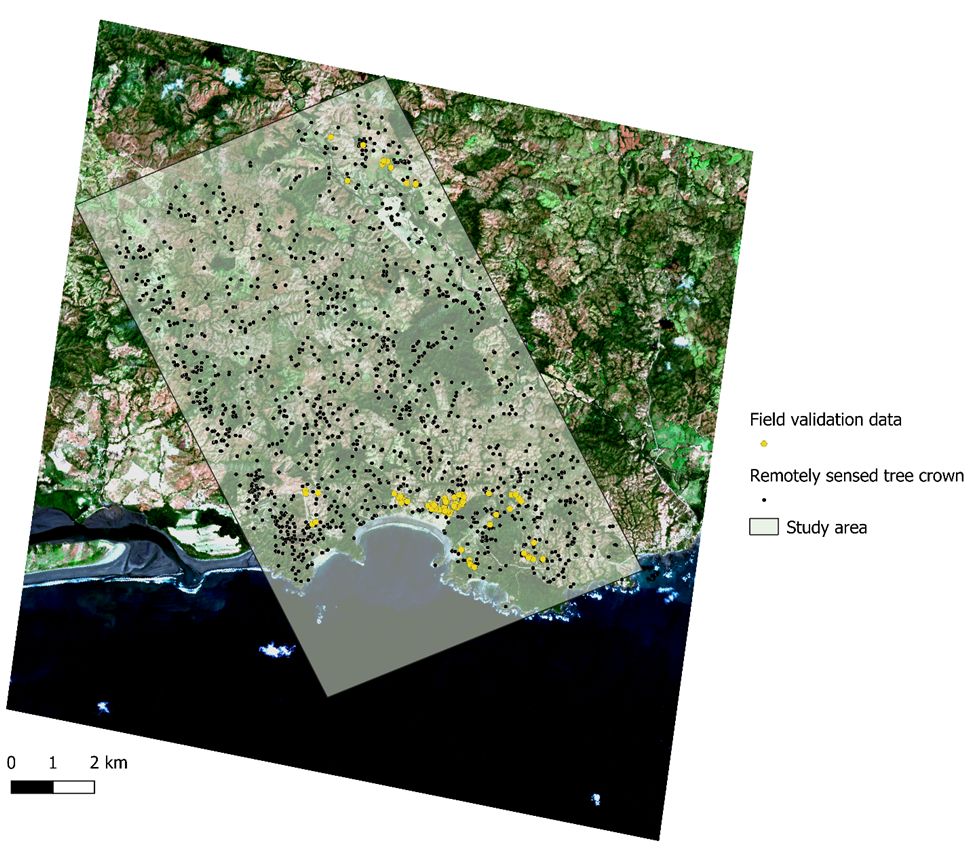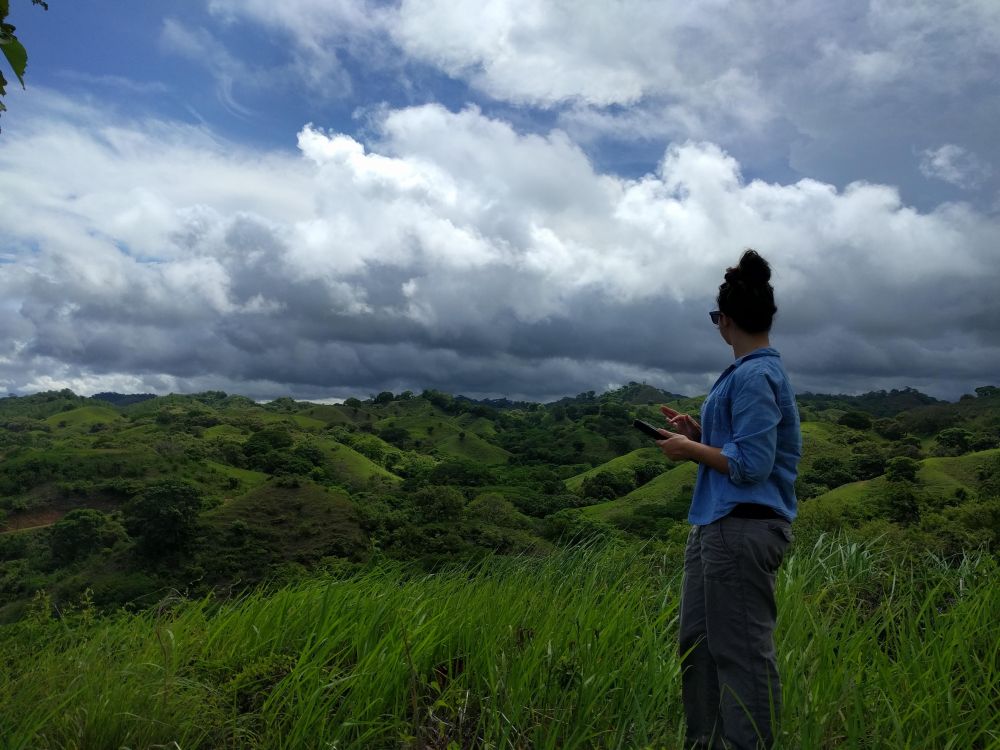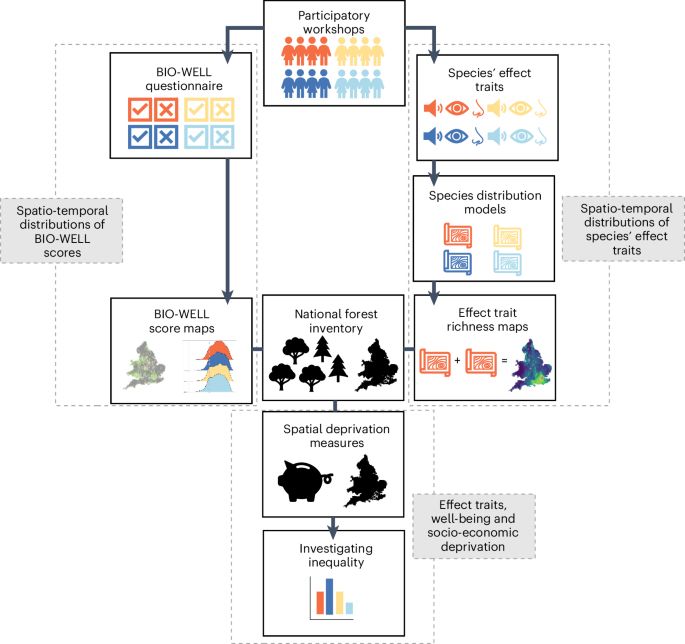Hurtado et al share that landscape connectivity significantly influences #carnivore communities, highlighting the need for its inclusion in #conservationplanning.🐾🌳 Learn more about their findings at doi.org/10.1111/cobi...
#conservation #science #carnivores #carnivoreconservation
30.07.2025 01:11 — 👍 0 🔁 1 💬 0 📌 0

July issue: Perspective led by Benoit Gauzens on the application of interaction networks to different ecological questions, and that provides guidance on selecting the appropriate type of interaction network. 🧪🌎
Web link: go.nature.com/3GLdOwN
Readcube: rdcu.be/ewqXc
16.07.2025 11:07 — 👍 4 🔁 2 💬 0 📌 0

Clearcutting doesn't mimic fire when it comes to biodiversity conservation - in the early stages of forest development at least. Congrats to Graham Frank on the publication of his PhD chapter! esajournals.onlinelibrary.wiley.com/doi/10.1002/...
25.06.2025 16:05 — 👍 18 🔁 7 💬 1 📌 1

A map of tree crowns in southwestern Panama, showing satellite imagery of a tropical landscape

A scientist surveying trees in a pastoral landscape with a GPS unit
🚨 New paper, led by Cristina Barber. We used high-resolution aerial imagery to study tree mortality in a tropical landscape. Large, isolated trees were most likely to die--alarming finding! @ecologicalsociety.bsky.social esajournals.onlinelibrary.wiley.com/doi/10.1002/...
11.06.2025 21:49 — 👍 30 🔁 14 💬 0 📌 2

Model schematic. The top panel shows individuals’ physiological response to water limitation. When soil water exceeds the critical content, individuals are active, transpiring water and accumulating carbon. When soil water drops below this threshold, they shut down, no longer transpiring, & lose carbon accumulated previously. Soil water is replenished by rainstorms at constant intervals. Panel B illustrates the dynamics of a single species starting at low density. Initially, the population is too small to deplete soil water to its critical level, so it remains active. After the next storm, the individual uses accumulated carbon for growth and reproduction, but eventually transpires enough water to shut down. The species consumes water faster & shuts down earlier in each subsequent interval, reaching equilibrium at its break-even time. Panel C shows the same dynamic with 2 species, where the less drought-tolerant species (1) shuts down earlier than the more drought-tolerant species (2)
🆕 & #OpenAccess in Ecological Monographs: Despite stiff competition for limited resources, countless plants can coexist if they face a trade-off in how they compete for water vs light
📄Trait diversity in plant communities maintained by competition for water and light
doi.org/10.1002/ecm....
10.04.2025 16:37 — 👍 4 🔁 3 💬 0 📌 0

Wild bees thrive among diverse flower communities, Concordia study shows - Concordia University
A mix of corolla sizes offers strong opportunities to promote urban biodiversity, according to Carly Ziter.
A nice write up on former MSc student Serena Sinno's work on urban pollinator conservation (that I missed - since Concordia is still over there tweeting on X 🤦). www.concordia.ca/news/stories.... Dedicated students measured hundreds of flowers to show the importance of floral trait diversity!
18.03.2025 03:21 — 👍 63 🔁 18 💬 3 📌 3

Illustration of the geometric approach to beta diversity. Panel (A) shows 2 hypothetical metacommunities; the 2 communities of metacommunity 1 consist of species A only and species B only. The 3 communities of metacommunity 2 consist of species A only, species B only, and species A,B together, respectively. Panel (B) shows that classic measures of beta diversity assert that metacommunity 1 has a higher beta diversity than metacommunity 2. Panel (C) illustrates the key steps of our geometric measure: turning the metacommunities into matrix representations, a geometric embedding of the metacommunity, and measuring the beta diversity as the normalized hypervolume of the geometric object. Within this measure, metacommunity 2 has a lower beta diversity than metacommunity 2, opposite to the classic measures.
🆕 in Ecological Monographs' "Method" section: Inspired by work showing "a community is more than the sum of its parts," a new geometry-based measure of beta diversity captures changes in species interactions
📄A geometric approach to beta diversity
esajournals.onlinelibrary.wiley.com/doi/full/10....
20.03.2025 14:02 — 👍 5 🔁 4 💬 0 📌 0
Our department (@EEBUofT) is searching for a Post-Doc! Post-docs funded by this fellowship are independently supported, with research funds available. We invite applications from innovative, collaborative candidates. See the job ad here:
eeb.utoronto.ca/wp-content/u...
18.03.2025 18:29 — 👍 69 🔁 66 💬 5 📌 3

Our new open access paper out in Earth's Future👉
agupubs.onlinelibrary.wiley.com/doi/10.1029/....
In the paper, we demonstrate how assisted natural regeneration can act as a cost-effective NbS to be beneficial for both biodiversity and climate mitigation, and identified priority areas as per 30×30
11.03.2025 18:13 — 👍 0 🔁 0 💬 0 📌 0

Thank you for choosing…
Click on the article title to read more.
A good opinion piece from the EiC of FEE: esajournals.onlinelibrary.wiley.com/doi/10.1002/...
I find society-owned journals more rigorous, and more supportive to the scientific community. Whenever possible, let's give society journals more support as well @esajournals.bsky.social.
04.03.2025 00:01 — 👍 8 🔁 7 💬 0 📌 1
A really cool piece! We also have a paper about urban weeds out in this issue, and it might be interesting to examine different roles that weeds and cultivated vegetation play in supporting pollinator diversity among different habitat types (say, natural vs. managed vs. riparian greenspace)
27.02.2025 20:58 — 👍 3 🔁 0 💬 0 📌 0
Catedrático de la Universidad Politécnica de Madrid - Full professor @upm.es.
Centro para la Conservación de la Biodiversidad y el Desarrollo Sostenible.
ETSI Montes, Forestal y del Medio Natural.
https://www2.montes.upm.es/personales/saura/
AAG brings together members of the global geographic community. We are an academic & professional organization representing educators, researchers, & practitioners in geography. https://www.aag.org/membership/
The official journal of the Society for Ecological Restoration (SER). Account curated by EIC Stephen Murphy. Post can be sporadic so do email me or ping me at my main acct: smurph.bsky.social
Professor at UCLA | Community ecology | Functional ecology | Serpentine grasslands | Tropical forests | Biogeography. Child wrangler, music lover, cyclist. Pro kindness. https://sites.lifesci.ucla.edu/eeb-kraft/ 🌱🧪🌿🌳📈🌐
Senior Research Scientist with the Canadian Forest Service. 🍁
#Landsat super-fan. #Lidar. #Forests. #Remotesensing. 🌲🛰
Member of the #OrderOfCanada. 🎖
📎https://www.researchgate.net/profile/Michael-Wulder
Remote sensing researcher.Cartographer.
Canadian Forest Service.
Official Bluesky page of the Policy Studies Journal (PSJ), a premier outlet for theory-driven policy research.
Ecologist interested in community dynamics and multiple stressors | DECRA fellow at University of Queensland | Research: https://jamesaorr.github.io | Nature photography: jamesorrphoto.com
Wildlife, trees, terrestrial ecology, night, trees, corvids, coffee, cats. | Nocturnal (DSPD). AuDHD. They/them.
My nonhuman animal equivalent is the badger.
"Night is a world lit by itself."
—Antonio Porchi
Full Professor of Aquatic Ecology University Zurich & @eawag.bsky.social | Kuratorium Forum Biodiversity | Founding Director https://biodiversitaet.uzh.ch/en.html | all & beyond #biodiversity, #eDNA & #AquaticEcology | Like=interesting
www.altermattlab.ch
Canadian Institute of Ecology and Evolution - Canada's national synthesis centre for ecology, evolution, environmental science. Funds and organizes working groups, workshops, graduate course. Leader in open science. Includes the Living Data Project
Researcher, professor, mom, outdoor enthusiast, global citizen
Professor of Ecology & Conservation. Director of Expertise - Ecosystems in School of Natural and Environmental Sciences @newcastleuni.bsky.social, UK. Researching network ecology/environmental change. Senior Editor
@animalecology.bsky.social. Views my own
Ecosystem scientist and biogeochemist, urban ecology and urban futures, resilience to climate change and extreme events. 46+ years at Arizona State University. Mom - grandmom - dog mom ❤️ SLC
Professor of ecology, forest biodiversity, Oregon State University, Lead PI HJ Andrews NSF Long-term Ecological Research Program @uslter, https://flel.forestry.oregonstate.edu
Discover new research from across the sciences and highlights from the world's longest-running journal archive. Part of @royalsociety.org royalsociety.org/journals
(he/him/his) Ecologist working on biodiversity-related questions | Climate change and range dynamics | Anything related to bugs | Editor-in-Chief @ESAMonographs
https://www.linkedin.com/in/jean-philippe-lessard-41a534109/
Conservation Biologist
Wildlife | Travel | Politics
Insta: @trailofatraveler












